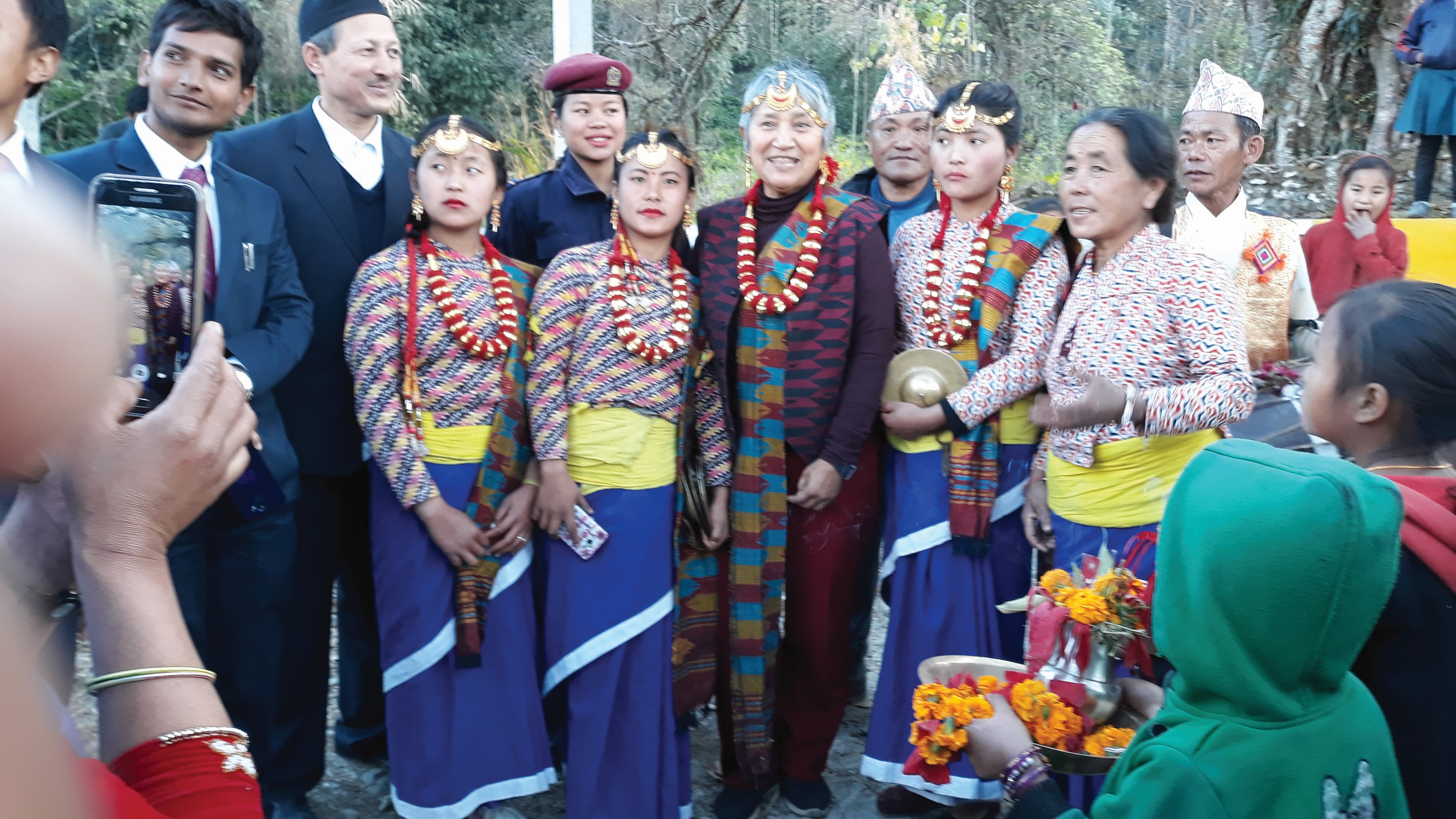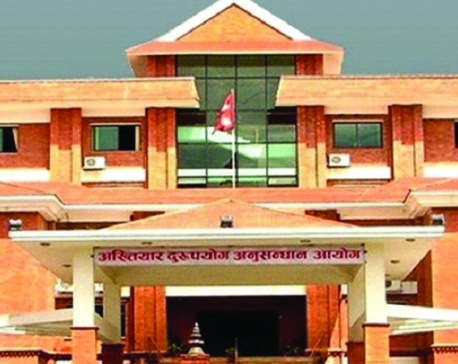
OR


Hisila Yami
Hisila Yami, former Minister of Physical Planning, Tourism and Land Reform, is a senior leader of Janata Samajbadi Party.hisila.post@gmail.com
After the construction of North-South roads along Koshi, Gandaki and Karnali rivers, Mid Hill Highway will assume greater strategic importance
When other political parties are vaguely talking about development, Naya Shakti Party Nepal (NSPN) decided to look into it concretely. At a time Prime Minister K P Oli is talking big about bringing in railway lines and ships from neighboring countries we decided to inspect what we already have within our country and what we can do more. So we took up a journey along the Mid Hill Highway, whose construction I initiated in pieces when I was the Minister of Physical Planning and Works in 2007, for this.
When Baburam Bhattarai was Finance Minister in 2008 he expedited its construction by allocating substantial budget for it. When he became the Prime Minister in 2011 he further earmarked it as one of the 16 National Pride projects. He knew that this road could be a game changer for Nepal.
It is worth remembering that we trekked many parts of Nepal when we were leading the guerilla warfare in 1996 under the banner ‘let us march forward under People’s War’ to destroy feudal structure under Communist Party of Nepal (Maoist). Now in 2019 we were marching under the banner ‘good politics and inclusive development’ under NSPN to construct New Nepal.
We started from Chiya Bhanjyang in Panchthar on January 29 and reached Jhulaghat in Baitadi on February 27 covering 27 districts. Travelling through 1879 kilometers distance within a month was a new experience for us. Baburam Bhattarai is not only the architect but also a regional planner while I am both an architect and a housing specialist.
We were joined by Madan Rai, an agriculture expert, Prashant Singh, a chartered accountant by profession who has been trained in Harvard and Oxford University, Dambar Khatiwada, Ganga Narayan Shrestha, Ishwor Rizal, Roshan Pokharel and Birendra Shrestha—personalities with expertise in their respective fields. Many more people from respective regions joined us in the tour along the Mid Hill Highway.
What we saw
When we reached Chiya Bhanjyang border, we found that there was Indian sentry but none from Nepal side. We confronted with bout of snowing in middle Nepal between Baglung and eastern Rukun. We nearly decided to divert our route via Tarai. Once again we took risk and made through with the help of excavator clearing the road for us. And in our last meeting in Gothalapani in Baitadi, snow accompanied with gale of wind. While returning from Baitadi to Kailali our car nearly slipped down on slippery ice. Throughout the journey we had to wade across unfinished road, ditches and pass through falling rocks and landslides. At one point, we lost our way in Dailekh.
But the journey had its rewards too. We were closely in touch with nature: snow-capped mountains, rocky dry mountains, green lush mountains, rivers and green pastures. As a former tourism minister, I saw great tourism prospects in these places.
I and Baburam Bhattarai observed the design of houses and pattern of settlement. We found that Eastern region was relatively well off with blend of traditional and modern architecture. The houses and surroundings were relatively clean.
Far-west was much poorer with less access to electricity, internet, drinking water and sanitation. We saw people beginning to construct earthquake resilient houses in the hills.
Our driver, Hem Adhikari, played songs of all 27 districts. I found the language, music of far western region very distinct and interesting. We also dressed in traditional attires of Eastern, Middle and Far-Western region to respect their culture.
Since our mission was inclusive development, we were well received by people and representatives of local bodies throughout the journey. We were touched by the warm gesture shown by Mayor of Dullu in Dailekh district whose father was killed by Maoists during the People’s War. Baburam Bhattarai acknowledged Maoist war but also regretted apolitical killings.
Local leaders and representatives of local bodies shared their plight with us. Most of the questions asked were related to lack of water, irrigation and delay in road constructions. Most people questioned the validity of earmarking 31 meters on both sides of the road saying that this standard was too high for mountainous region.
As Baburam Bhattarai is the representative in federal parliament and also the member of Finance Committee of the parliament, they expressed the hope that he will work to address their problems. Most local bodies lacked officials. Most of them had never received former prime minister and minister at their offices before. It was nice to see different local bodies proudly welcoming us.
As the student of distinction during his school and college days, Baburam Bhattarai was particularly sought after by students and teachers of schools and campuses. These schools and campuses were struggling with lack of funds, facilities and teachers. There were more female students than males. Female attendants outnumbered men in mass meetings and interaction programs.
I was most disappointed when I reached Lukum in eastern Rukum, one of the bastions of People’s War. Things had not changed much there even after People’s War and peace process. The households there had no toilets and no electricity access. The rooms were poorly lit and ventilated. It reminded me of Viker’s museum that I saw in York city when I was studying in the UK. What surprised me was every house in the village had some member going abroad to work. And yet the remittance money seems to have no effect in their living style. I felt guilty to see it in the same situation even after People’s War. Hopefully, the mid-hill road that runs through this village will bring some changes in the future.
In Marshangdi River in Lamjung many bridges were made while there was none to connect Western Rukum with Jajarkot. Also in few places there was dispute in the course of Mid Hill Highway as the influential locals tried to divert roads from its original course in order to bring near to their village or house, further delaying road construction.
When I compare Nepal from global perspective I find it quite rich in terms of resources, but when analyzing locally it fares poorly because of lack of vision of mainstream politicians.
Highway hopes
Mid Hill Highway is based on old postal trekking road. Its upgrading to two-lane motorable road can regenerate economic activities and repopulation along the road. Already new construction activities around road sides are taking place. In some places new settlements are coming up, in some expansion on already old settlement is taking places. However there was lot of concern about haphazard construction of local roads that were being constructed without regards to environmental safety. Similarly many buildings were sprouting without consideration of land use plan.
Many restaurants, shops and hotels are coming up. Many private schools are opening and it was heartening to see tempos going to and fro picking up passengers on short trips. Many are rearing poultry, buffalos, cows, goats and growing high breeding crops. Above all this road will help in coordinating and connecting six regions out of seven and will help in fusing and interacting with seven ethnically and regionally oppressed communities.
It will break isolations of geography and make people more mobile. This in turn will generate entrepreneurship in villages and municipalities which is badly lacking in Nepal. After the construction of North-South roads along Koshi, Gandaki and Karnali rivers, Mid Hill Highway will have more strategic importance generating more urban and industrial nodal points. In future Mid Hill Highway could be life line for all the mountainous regions from Afghanistan to Burma.
hisila.post@gmail.com
You May Like This

Local Election, National Importance
Democracy seems to delight people only as long as they feel they are getting fast, fair and free services from... Read More...

Corruption in local governments still remains unchecked: CIAA
KATHMANDU, Dec 24: The Commission for the Investigation of Abuse of Authority (CIAA) has said it received the largest number... Read More...

Local bodies’ associations call for revision in laws
KATHMANDU, Oct 20: The National Association for Rural Municipalities in Nepal (NARMN), an umbrella organization of local bodies in the... Read More...







Just In
- NRB to provide collateral-free loans to foreign employment seekers
- NEB to publish Grade 12 results next week
- Body handover begins; Relatives remain dissatisfied with insurance, compensation amount
- NC defers its plan to join Koshi govt
- NRB to review microfinance loan interest rate
- 134 dead in floods and landslides since onset of monsoon this year
- Mahakali Irrigation Project sees only 22 percent physical progress in 18 years
- Singapore now holds world's most powerful passport; Nepal stays at 98th











Leave A Comment